The motto of this year's International Day for Biological Diversity is "Building a shared future for all life". And the vision for 2050, according to the CBD, is to "live in harmony with nature". How can this be achieved?
That is of course a relevant goal. But it is not measurable. What does "living in harmony with nature" mean? How can we tell when we are doing it? And which steps that are measurable would be the right ones? We need to question this. For example, there is the 30-30 target. This means that 30 percent of the world's area should be protected by 2030. The question is: Who chooses these areas? And what does that mean, for example, for the developing countries’ perspectives? Plus, putting an area under protection does not mean that this will be accepted, monitored and sanctioned. So, we need targets along the way that are measurable, that can be implemented with management measures and that many can agree on. That is the enormous difficulty. We can only solve this globally – similar to the climate crisis. Of course, this also means that there has to be a lot of discussion about balancing interests. In order to achieve that we need a framework like the CBD, and the IPBES (Intergovernmental Science-Policy Platform on Biodiversity and Ecosystem Services), which summarises the state of the science.
Are there any positive examples of how such protection can succeed?
For example, it is a great asset that a large part of Germany's Wadden Sea coast is under protection. High effort is made to monitor the area and assess its condition. But there are also limits: Certain activities are not prohibited, such as fishing, shipping and so on. And we can't protect the system from certain influences, such as warming or inputs via rivers. So, it is not enough to protect only one part of the system. Also, it is not about defining an ideal world. There is no such thing as nature unaffected by humans. We can only reduce impacts and we have to think of nature together with people and not nature against people.
The topic of climate change, for example, plays a big role in public debates, but the topic of biodiversity not so much. Why is that?
I think it's because of two things. The first is: when we talk about climate, we talk about things that every person immediately understands, for example temperature. We have a scale, and we know: 20 degrees Celsius is warm, five degrees is cold. Biodiversity is a very complex property of living communities. You can count how many different species there are, or look at how interconnected these species are. There are many different aspects of diversity that are not as easy to communicate as temperature. Secondly, biodiversity change is much more complex than climate change. Of course, the climate system is also complex. But what we are seeing is an increase in temperature. What we see with diversity is that some species go extinct while other species are coming in. The dominance of species is changing. And all these aspects are happening simultaneously. So we have a very diverse happening that you can't just show with a curve, for example.
How can we draw more attention to the importance of biodiversity?
From my point of view, it is important to impart knowledge about biodiversity. Not only in schools, but also in further education. We have to work towards people understanding what biodiversity actually is. Because recognising how nature changes is not like feeling a warming on your skin. You have to go there and look at it. But often we take nature for granted – the fact that something grows and we have food. But the fact that fruit, for example, does not grow without pollinators and that in areas where pollinators have become scarce, we have to pollinate by hand, is an example that shows how important biodiversity is. The crucial point is: biological diversity plays a central role for us humans, we are fundamentally dependent on nature. We must recognise and appreciate this.
Interview: Constanze Böttcher




